Observation | The story of the application layer is difficult to continue. How does the public chain live through 2020?
Since 2016, most of the public chains have been developing according to the same story template–launching the mainnet, establishing a developer community, and building DApps; but now this development route has not worked, both for investors and speculators. Tired of this logic.
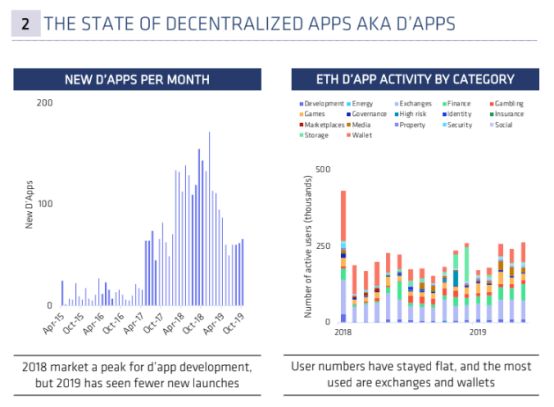
The picture on the left is the number of new DApps per month from 2017 to 2019 (data from CoinShares)
According to the crypto asset depth report released by CoinShares last month, the number of newly launched DApps, which increased by more than 100 per month last year, has dropped significantly by early 2019. Compared with 2018 in which decentralized applications prevailed, this year's DApp market can basically be described as bleak. Not to mention that no killer applications have been run out, and even games that quickly die with fire are becoming scarce. Although the market size is still expanding, it is not to be ignored that nearly 75% of DApps are currently unattended (data source: DappTotal).
- Yao Qian: Quantum Money: An Academic Imagination
- Ethereum 2019: year after year, continuous expansion
- China Mutual Fund Association: Tips on Preventing Risks of ICO and "Virtual Currency" Trading Activities in the Name of Blockchain
As the story of developing DApps gradually becomes outdated, how the public chain should establish the ecology and what to do after the main project of the new project seems to have become a major issue that the market urgently needs to pay attention to .
Looking at the trend from the head, the routine of the application layer of the public chain fails
As a native application of the blockchain, the DApp market has always been a battleground for the public chain team, and it is also the field's hope for the landing of the blockchain. However, due to the real-world problems such as blockchain performance bottlenecks and network security, in addition to DeFi being able to set off some waves, DApps have not made much progress in 2019, and have fallen into a more difficult development stalemate.
Taking the head public chain project as an example, Ethereum, which has increased daily user activity due to DeFi in the middle of the year, has gradually entered a development bottleneck period. From the third quarter, many DApps have stopped on transaction volume, number of transactions, and number of locked positions. In addition, EOS and TRON, which have comparable DApp totals, account for more than half of the market ’s activity coming from lotteries and gaming games. The daily transaction volume of both of which is higher than Ethereum is also suspected to be caused by robots. , Not the actual use of the user.

Activity of DApp users in ETH, EOS, TORN networks (data from: DappTotal)
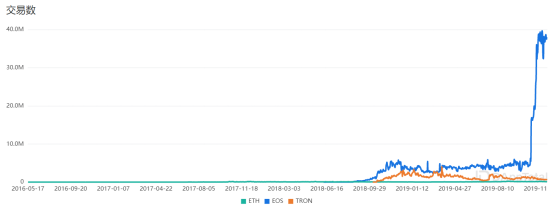
Daily DApp transactions in the ETH, EOS, TORN networks (data from: DappTotal)
The development of the head project DApp ecology has stalled, and the current status of other public chains is even worse. Moreover, the decentralized application market has obvious faults . According to incomplete statistics, more than 90% of DApps and users in the field are Concentrated on the three major platforms of Ethereum, EOS, and TRON, and the number of daily active users of the explosion models of the remaining public chain platforms is less than one thousand. Although many analysts believe that the current decentralized applications are still at a very early stage, as long as other projects can run out of killer applications, the public chain pattern may change at any time, and it will not be too far from the historical singularities of DApps. But now that competition is becoming more homogeneous and the altcoin market is sluggish, there are not many opportunities left for other public chains.
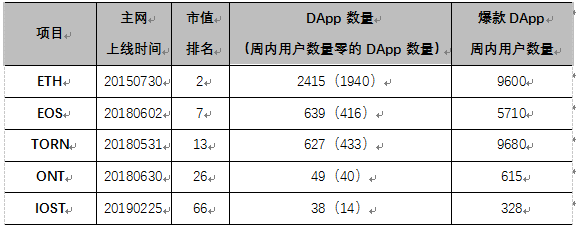
Data source: DappRadder, DappTotal, Coinmarketcap
Theoretically speaking, the public chain market has entered the blowout period from the exploration stage to a lot of public chains that are more innovative than head projects, but performance is only a prerequisite for the development of the DApp market, and user habits are the key. In the competitive currency market, which has no improvement in the market, it is not easy for the emerging public chain to establish a retail community. Last month, the founder of QuarkChain also expressed the same point of view in an interview. In his opinion, the practice of growing the retail community and organizing hackathon activities to attract developers, as in the past, has little significance for the public chain ecological construction. "Because the current DApp is in a weak state, the foreseeable outbreak is distant, and the homogeneity of different public chains is serious, DApps can run on different platforms." In this context of lack of users and no high-quality decentralized applications With the passage of time and its speculative value, related projects will face the risk of being eliminated.
New trends are beginning to emerge, and the public chain market urgently needs to find new ways
Because of this, in order to consolidate its position in the field or to gain a foothold in a saturated market, more than forty public chain projects that are currently on the mainnet and nearly twenty public chains that will be launched next year are actively looking for new ways to break the game. road. Among them, the main public chain platforms led by Ethereum are gradually moving closer to the financial field, and in star projects including Cosmos, Nervos, etc., and domestic public chains that have attracted much attention recently, we can also see some different developments. trend.
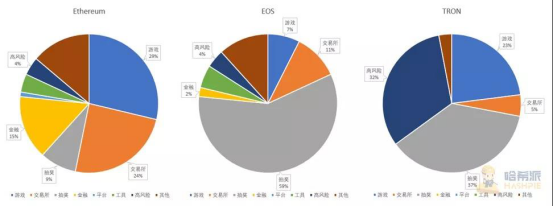
Distribution of Dapp types of each public chain (data from: DappTotal; collection time: 20190905; sampling is the top 100 DApps on the day of the user)
In fact, in addition to the above-mentioned technology and market issues, the phenomenon of the construction environment of public chain applications slowly shifting from the main network layer to the bottom layer is also one of the reasons affecting the development of the DApp market. Unlike the DApp ecosystem that needs to be attached to the public chain, after the rise of Polkadot and Cosmos, which are dedicated to one-click chain launch, market participants such as exchanges, star applications, etc. can all use their cross-chain projects to help them through their districts. The block chain framework builds its own chain, thereby quickly entering the game. This method of setting up a base for industry peers brings a new story to the underlying public chain; allowing related projects to expand into the current stage of vertical ecological construction bottlenecks by publishing new chains or combining more blockchains Own ecology.
Judging from the current development situation, Cosmos, which has been on the mainnet for less than three quarters, has released large-scale projects such as IRIS Betwork, Binance DEX, Kava, Aragon, etc .; it has been selected by Bloomberg as one of the four most worthy projects this year. When Nervos released the benchmark Substrate blockchain development framework muta last month, it has helped Huobi develop its own chain; while Polkadot, also built on Substrate, has not yet officially launched the mainnet, and more than 35 projects have used its basic framework. Build relevant platforms. As for QuarkChain, although different ways of breaking the game are adopted, trying to access the old currency through the underlying structure of the root chain + shard chain; but the way these projects expand their ecology can not be separated from the word "alliance" .
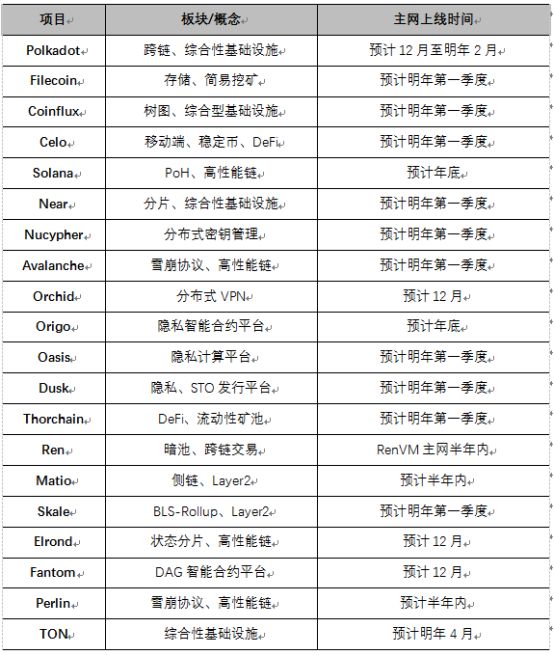
The main chain public chain project will be launched in 2020 (data from the network)
Form a large alliance with other blockchains, help more mature or have a certain user base project launch chain, while the relevant public chain will include the project in its own ecology; it also alleviates the performance and cost problems that cannot be avoided in the vertical ecosystem to a certain extent . For this reason, compared to the continued consumption of funds and the patience of users in the DApp market, the star projects CryptoKitties and Aragon, which have been hot on Ethereum, have launched into the sea one after another this year, announcing the development of their own blockchain. Among them, Aragon, who chose the Cosmos distribution chain, said frankly that the transaction costs on the Ethereum chain discouraged many users, and that the unknown path of upgrading the underlying network also added a lot of unforeseen future costs to the project.
From these perspectives, the establishment of a parallel-chain ecological environment does have some mutually beneficial effects on the public chain and the project. And practitioners in the field, including the founders of NEO, have predicted that one-click chain launch and Wanchain interconnection will become the future trend of the blockchain market. But as the Aragon team members said, "Choose a hair chain is only an alternative or transition plan to meet current needs and achieve goals"; this trend will develop into a so-called public chain ecology in the future, or will it remain as an indirect means to achieve the ultimate goal In history, it is unknown .
But no matter which way the public chain ecology will develop in the future, for the public chain projects currently in an awkward period of development, finding breakthroughs in a timely manner, maintaining market heat, and striving to balance revenue and expenditure are the first tasks to survive the cold winter. Otherwise, even if it can prove that the story of the application layer is the future, the project that sticks to the ground may not be able to survive the day when the goal is achieved.
References
[1] "2019 Crypto Trends Report", CoinShares
[2] "For the public chain, the story of the application layer is dead", Orange Book
(Source: Hash school; Author: LucyCheng)
We will continue to update Blocking; if you have any questions or suggestions, please contact us!
Was this article helpful?
93 out of 132 found this helpful
Related articles
- Long Baitao Comments: Comparing the Development and Supervision of Large Chinese and German Technology Companies
- The finale of the American drama "Silicon Valley": a crisis caused by a blockchain expansion
- Reuters: Netherlands' largest bank to enter digital asset custody industry
- Medical data of 40 million members will be protected, Anthem, the second largest health insurance giant in the United States, uses blockchain like this
- Zhu Jiaming's latest sharing: Understanding the evolution of blockchain paradigms from a futuristic perspective
- Alliance Chain Player Consensus: Take orders, card position, live, there is still a long way to go!
- Wikipedia Lightning Network Entry Critical? Bitcoin was deleted 9 years ago




